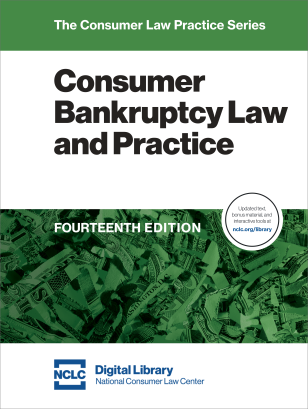Bankruptcy Dollar Amounts Going Up
Bankruptcy Code § 104(b) provides that the exemption amounts and other dollar figures in the Code are automatically adjusted for inflation every three years. The adjustments are based on changes to the Consumer Price Index for All Urban Consumers published by the Dept. of Labor, rounded to the nearest $25.
New dollar amounts take effect on April 1, 2022, and will apply to all cases filed on or after that date. Many lower-income bankruptcy filers already can retain all or almost all of their assets in a chapter 7 bankruptcy. The new higher exemption amounts mean that it is even more likely that consumers can protect their assets in a chapter 7 filing.
New Exemption Amounts Protect More Consumer Property
Consumers in states that have not opted out of the federal exemptions may claim the bankruptcy exemptions under Bankruptcy Code § 522(d), as discussed in NCLC’s Consumer Bankruptcy Law and Practice § 10.2.1.1. The federal bankruptcy exemptions may also be claimed in some cases if the “safe harbor” in section 522(b)(3)(A) applies because the consumer is ineligible for any state exemption due to the domiciliary requirement, even if the state of the consumer’s domicile is otherwise an opt-out state, as discussed in NCLC’s Consumer Bankruptcy Law and Practice § 10.2.1.2. Exemption amounts refer not to the value of property, but to the consumer’s equity interest in the property after deducting outstanding credit secured by that property. The exemption amounts in Code § 522(d) are doubled when a married couple files a joint case. 11 U.S.C. § 522(m).
For a state-by-state summary of state exemption amounts that apply to bankruptcies in certain states and that also protect property from seizure by judgment creditors, see NCLC’s Consumer Bankruptcy Law and Practice Appx. J. The same state-by-state survey is found in NCLC’s Collection Actions Appx. H, and Appendix H for a limited time is open to the public.
The following are the new exemption amounts, effective April 1:
| Homestead - § 522(d)(1) | $27,900 | |
| Motor Vehicle - § 522(d)(2) | 4,450 | |
| Household Goods - § 522(d)(3) | ||
| Per Item Limit | 700 | |
| Aggregate Limit | 14,875 | |
| Jewelry - § 522(d)(4) | 1,875 | |
| Wild Card - § 522(d)(5) | ||
| Any property | 1,475 | |
| Unused homestead under § 522(d)(1) | 13,950 | |
| Tools of the Trade - § 522(d)(6) | 2,800 | |
| Unmatured Life Insurance - § 522(d)(8) | 14,875 | |
| Personal Injury Claims - § 522(d)(11)(D) | 27,900 |
The cap on homestead property acquired within 1215 days before the bankruptcy filing under Code § 522(p), and based to the commission of certain bad acts by the debtor under Code § 522 (q) will be $189,050. These limitations on state homestead exemptions are discussed in NCLC’s Consumer Bankruptcy Law and Practice § 10.2.3.4.
Exemption for Retirement Accounts
As discussed in NCLC’s Consumer Bankruptcy Law and Practice § 10.2.3.3, the federal bankruptcy exemption for retirement funds in pension plans and individual retirement accounts is available to all debtors, even those in “opt-out” states who would not otherwise be permitted to claim the federal exemptions. 11 U.S.C. § 522(d)(12) and § 522(b)(3)(C). The maximum dollar amount for this exemption also adjusts every three years. 11 U.S.C. § 522(n). The new maximum aggregate value of funds in retirement accounts that may be exempted will be $1,512,350.
Exemption for Education IRAs, Tuition Savings Programs and ABLE Accounts
Certain property is effectively exempt because the Bankruptcy Code excludes it as property of the bankruptcy estate. The amount in an education IRA, a section 529 tuition savings program, and a qualified ABLE account that is excluded from property of the estate, if placed in such an account between 365 and 720 days before the petition was filed, will now be $7,575. 11 U.S.C. §§ 541(b)(5)(C), 541(b)(6)(C), 541(b)(10)(C). This exclusion from the bankruptcy estate is discussed in NCLC’s Consumer Bankruptcy Law and Practice § 2.5.3.
Other Dollar Amount Adjustments in the Code
The inflation adjustment also applies to other dollar amounts in the Code, including:
- Priority for wages and employee benefits under Code § 507(a)(4) will now be $15,150, and the priority for consumer deposits under Code § 507(a)(7) will be $3,350. Distribution to priority creditors is discussed in NCLC’s Consumer Bankruptcy Law and Practice §§ 3.5.4, 18.5.5.
- Debt limits for eligibility for chapter 13 under Code § 109(e) will also go up—to $465,275 in unsecured debt and $1,395,875 in secured debt. The chapter 13 debt limitations are discussed in NCLC’s Consumer Bankruptcy Law and Practice § 4.2.1.3.
- Threshold for the presumption of nondischargeability under Code § 523(a)(2)(C) for purchases of luxury goods or services incurred within 90 days prior to filing will be $800 and for cash advances within 70 days prior to filing will be $1,100. A discussion of when these presumptions arise can be found in NCLC’s Consumer Bankruptcy Law and Practice § 15.4.3.2.3.2.
- Dollar amounts under the means test for determining whether a presumption of abuse exists, based on the debtor’s income after expenses over a 60-month period, will now be: (i) $9,075 ($151.25 per month based on 60 period) or 25% of nonpriority unsecured debt, whichever is greater, or (ii) $15,150 ($252.50 per month). 11 U.S.C. § 707(b)(2)(A)(i). These dollar amounts are discussed in NCLC’s Consumer Bankruptcy Law and Practice § 13.4.6.1.
The minimum aggregate amount of property that a trustee may seek to recover as preference in a case filed by a debtor whose debts are not primarily consumer debts will now be $7,575. 11 U.S.C. § 547(c)(9). This limitation on a trustee’s ability to avoid transfers as a preference is discussed in NCLC’s Consumer Bankruptcy Law and Practice § 10.4.2.6.4.2.


